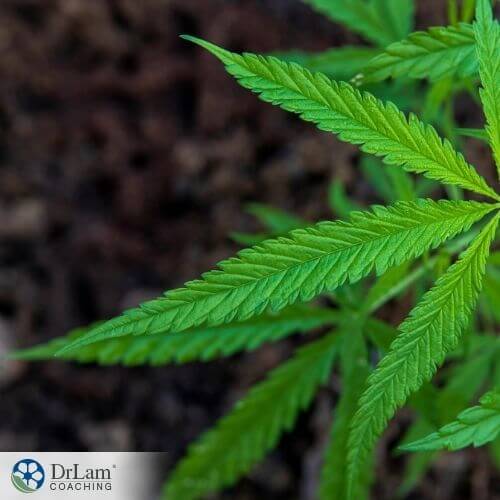 Medical cannabis comes from the cannabis sativa plant. You can use it medically for different symptoms and conditions. The cannabis sativa plant comes in two main varieties: hemp and marijuana. The hemp plant is high in cannabidiol (CBD) and low in delta-9 tetrahydrocannabinol (THC) concentrations. THC is compound that gives the "high" when the substance is consumed. Marijuana, on the other hand is high in THC and low in CBD. Generally, hemp has less than 0.3% THC, and CBD is legal to consume in the US.
Medical cannabis comes from the cannabis sativa plant. You can use it medically for different symptoms and conditions. The cannabis sativa plant comes in two main varieties: hemp and marijuana. The hemp plant is high in cannabidiol (CBD) and low in delta-9 tetrahydrocannabinol (THC) concentrations. THC is compound that gives the "high" when the substance is consumed. Marijuana, on the other hand is high in THC and low in CBD. Generally, hemp has less than 0.3% THC, and CBD is legal to consume in the US.
» Read our complete long-read article on medical cannabis
» Adrenal Fatigue FAQs
» Take our 3-minute test to see if you may have Adrenal Fatigue
In most US states, as well as most countries around the world, cannabis is only used under strict regulation. Cannabis sativa and its derivatives, except CBD, are controlled substances in the US. That means there are prohibition laws around how and when they are used, if at all.
Although both CBD and THC can both be used medically for different purposes, different states have varying laws for the use of cannabis, especially the type that contains higher THC levels. These laws are expanding as new research emerges about the benefits and risks of using medical marijuana.
In this article, we will focus on the current state of medical cannabis use as well as some of the possible risks and benefits you might want to be aware of in case you’re considering trying it out. This also goes for if you're considering using CBD for your kids. We’ll also discuss how it might affect those with adrenal fatigue and chronic stress.
Legally, there are certain “qualifying conditions” that you are allowed to use medical cannabis for. Those include the following:
But even if you have one or more of these conditions, you don’t automatically qualify for a prescription. It depends on your state’s laws as well as the severity of your symptoms. But you can always check with your doctor regarding these issues and whether it would be a good idea to give cannabis a try. Just be aware that even if it is legal in your state, not every doctor is willing to prescribe it.
Some people use cannabis for conditions that may not yet be considered qualifying, such as anxiety, but we do not recommend that you try any substances, natural or not, without approval from your doctor or health professional first.
Cannabis can be either administered as it is in plant form or as one of its derivative substances. Used in its natural plant form, its dry leaves and buds can be smoked. Derivative substances include topical solutions you can rub onto your skin, oral solutions, oil that you can use for vaporizing, edibles like brownies or cookies, and in pill form. Some prescription medications use CBD or cannabis-related substances, such as nabilone and dronabinol.
If you’re prescribed cannabis, you will also be told how and when to use it, as well as how much to use. Depending on the severity of your symptoms and also the type of cannabis you’re using, you will need to adjust accordingly. For example, vaporization has the fastest effects, while CBD is slow but doesn’t create a high. It’s important to work with your healthcare professional to find the most suitable form for your specific condition and needs.
Many people also find cannabis is a good alternative when other medications are causing side effects. However, substituting medications can have a big impact on your condition as well, so it's important to talk to your doctor first.
 The human body produces cannabinoids endogenously, meaning it naturally makes substances very similar to compounds found in cannabis sativa plants. These endogenous cannabinoids, called endocannabinoids, are part of your endocannabinoid system (ECS). Along with these substances, your ECS also has cannabinoid receptors and the enzymes that synthesize and then degrade endocannabinoids, whether endogenous or exogenous.
The human body produces cannabinoids endogenously, meaning it naturally makes substances very similar to compounds found in cannabis sativa plants. These endogenous cannabinoids, called endocannabinoids, are part of your endocannabinoid system (ECS). Along with these substances, your ECS also has cannabinoid receptors and the enzymes that synthesize and then degrade endocannabinoids, whether endogenous or exogenous.
The ECS is named as such because it’s a system that was discovered when researchers were exploring what cannabis does to the nervous system. Since then, it’s been found to play important roles in the development of the central nervous system (CNS) as well as in synaptic plasticity. Plasticity is a term that describes how your CNS changes on structural and functional levels in response to what you experience.
But it’s not just limited to your CNS. The ECS can be found in different cells and tissues throughout your body. It is involved in many functions, including metabolism, immunity, body temperature, sleep, appetite, and the stress response. It’s needed for proper repair and for reaching and maintaining homeostasis. And, if you’ve ever used marijuana, you know how it can affect such functions, sometimes negatively and sometimes positively.
The most well-studied endocannabinoids till now are anandamide and 2-arachidonoylglycerol (2-AG), and the most abundant cannabinoid receptors found in the body are the CB1 and CB2 receptors. CB1 receptors are more involved with your CNS, and CB2 receptors are more involved with your peripheral nervous system (PNS). Other receptors include the transient receptor potential (TRP) channels, and the peroxisome proliferator activated receptors (PPARs). These endocannabinoid receptors are what enable your body to receive and react to cannabis. THC can bind directly to CB1 and CB2, while CBD indirectly modulates them.
This natural system is why exogenous cannabinoids work on your body. But just because cannabis is a natural substance, and just because you have an endogenous system that works with it, doesn’t mean it is always appropriate or safe. Any substance, natural or not, that has medicinal properties, will have risks as well. In this section, we will outline some of the risks that are specific to marijuana.
The first and most obvious issue here is that it can affect your coordination and your judgment. This means that you should not be driving or operating dangerous machinery. You are more prone to accidents and other injuries if you do not use it in a controlled environment.
Cannabis use can also lead to fatigue, bloodshot eyes, faster heart rate, dizziness, and low blood pressure. If you overdo it, you could end up with overdose symptoms, such as hallucinating or feeling faint. Used for long periods of time, there is a risk it could contribute to depression.
Smoking marijuana also carries certain health and safety concerns. For example, some people mix the dry leaves or buds with tobacco to make it burn more smoothly. This tobacco content is harmful to your lungs and may lead to lung conditions, including cancer. But even if you use it without combining it with tobacco, there’s some speculation that it can still be harmful to your lungs.
 The other risk, which is still debated, is dependency. Dependency means that when and if you decide to stop using medical cannabis, you may experience withdrawal symptoms. If you overuse it for a long period of time, it’s possible you may be at risk of addiction, where even if you want to stop using it you are unable to without intervention.
The other risk, which is still debated, is dependency. Dependency means that when and if you decide to stop using medical cannabis, you may experience withdrawal symptoms. If you overuse it for a long period of time, it’s possible you may be at risk of addiction, where even if you want to stop using it you are unable to without intervention.
Because of the possible risk of addiction, the National Institute on Drug Abuse considers marijuana a “gateway drug” that can lead users to other, more dangerous drugs, such as heroin or cocaine. This label is controversial, and so far there’s not much evidence to support the theory. But the US Drug Enforcement Agency (DEA) still currently categorizes it as a Schedule I drug, in the same class as heroin.
Cannabis is also not a prescription drug, except for the three medications mentioned earlier, so the Food and Drug Administration (FDA) doesn’t oversee the different cannabis products for sale on the market. This is another area of concern, as you can get products with different ingredients and different concentrations of active components. Some companies producing them are also not very careful with labeling their products, with some having very different ingredients than what they claim.
If you are considering using cannabis medically, you need to take all of these risks into consideration. This is especially true if you plan on using it for a medical purpose, as you may end up aggravating or complicating your condition further. Still, you may look into all of this and still come to the conclusion that it’s worthwhile. The most important thing is that you do so with the guidance of an experienced health professional.
Chronic stress is a huge problem in modern life. The fast pace, fast food, and convenience products of the 21st century may be allowing us to juggle all the different roles we need to play, but they come with a price. They can overload our system with stressors that you don't even know are there.
Chronic stress can be physical or psychological. And it can include things like a bad diet, overconsumption of sugar and simple carbs, exposure to toxins, unaddressed food sensitivities, smoking, leading a sedentary lifestyle, obesity, chronic inflammation, digestive issues, financial pressure, overworking, toxic relationships, and bad sleep, to name a few.
And although cannabis use is not a direct stressor per se, using it in order to suppress the stress doesn’t actually help. The stressors that created the problem are still there, and you might keep putting off dealing with them if you are using cannabis to cope. Inappropriate use of cannabis, like overuse, can become a direct stressor as well. It could cause lung problems, interfer with sleep and appetite, or contribute to mood, financial, or relationship problems.
What chronic stress does is overwork your NeuroEndoMetabolic (NEM) Stress Response, which is your body’s global response to stress. Your NEM is composed of six circuits of organs and systems that work together to fight stress. Your adrenal glands are part of the NEM’s Hormone Circuit, and they are your first responders to stress. They produce your body’s most important anti-stress hormone, cortisol. Cannabis affects this circuit as well as the Neuroaffect Circuit the most.
 So, let’s say you’re eating fast food all the time because you have a lot of work pressure and don’t have time to cook. You also don’t sleep well from the anxiety you feel, and you have to take painkillers frequently to fight off your tension headaches. And you use cannabis to get you through the day. The problem with these stressors is not that they cause acute stress, which your NEM is well-equipped to handle. The problem with them is that they are recurring - they are chronic.
So, let’s say you’re eating fast food all the time because you have a lot of work pressure and don’t have time to cook. You also don’t sleep well from the anxiety you feel, and you have to take painkillers frequently to fight off your tension headaches. And you use cannabis to get you through the day. The problem with these stressors is not that they cause acute stress, which your NEM is well-equipped to handle. The problem with them is that they are recurring - they are chronic.
That means that your adrenals are constantly working hard to produce more and more cortisol. Yet you’re not aware of what’s happening so you continue your lifestyle as is. At some point, your adrenals will get so exhausted that their cortisol output will drop completely. These are the early stages of Adrenal Fatigue Syndrome (AFS), and when your adrenals are weak, the rest of your NEM will follow suit.
Symptoms of AFS include fatigue, weight gain, sleep problems, brain fog, anxiety, mild depression, low libido, heart palpitations, inflammation, aches and pains, and frequent colds and flu.
And although cannabis that you use according to your doctor’s guidance can help with some of these symptoms, like anxiety, pain, and inflammation, it won’t fix the root of the problem. AFS and NEM dysregulation require that you tackle the stressors directly, by making changes to your diet and lifestyle. In that sense, cannabis should only be used as an adjunct to a core recovery program.
Like any drug, whether natural or synthetic, cannabis's benefits and risks are related to how and why you use it. In the case of adrenal fatigue recovery, some of its usually unwanted side effects may actually be useful, while some of its intended benefits may not. The following are two examples of this.
Most people feel more lethargic and tired after using marijuana. So deciding to include it as part of your adrenal fatigue recovery plan has specific caveats. The most prominent feature of AFS is fatigue, and medical cannabis might end up aggravating this symptom in the short term. If this added fatigue causes more stress or gets in the way of sticking with your recovery plan, then it may not be worth the benefits.
However, AFS recovery also requires a lot of rest and sleep. In that way, if cannabis will help you relax and get more sleep, the relaxation and lethargy it can induce may not be such a big issue after all.
Another prominent symptom in AFS is easily gaining weight and having difficulty losing it. One of the reasons HIV/AIDs and cancer patients take medical cannabis is to stimulate their appetite. This may be a problem if you have AFS. Although we do not advocate for calorie restriction in AFS recovery or under most circumstances, weight gain beyond a certain point becomes a stressor in its own right.
But if you are following the adrenal fatigue diet, which is the cornerstone of AFS recovery, then you won’t be too at risk of overeating or consuming empty calories.
Other important components of adrenal fatigue recovery include a supplements protocol, stress management, sleep hygiene practices, gentle forms of exercise, and possibly some forms of herbal remedies and natural hormone therapies. If you would like to know more about AFS and NEM recovery protocols, you can get in touch with our coaching team with any questions.
Generally speaking, we’ve been looking at medical cannabis, mainly the marijuana variety, for helping relieve symptoms of chronic conditions for adults. But CBD oil and medications made from CBD have been used for conditions that affect children as well.
The most striking of these is severe seizure disorders. Epidiolex is a drug made from CBD. And the FDA approved it for treating people, including children, who suffer from drug-resistant seizures. It seems to be quite effective from what studies have found.
Some parents also swear by CBD’s effectiveness in relieving symptoms of ADHD and anxiety in their kids. Of course, if you are a parent and are thinking about CBD oil for your child, you should talk to your pediatrician first.
 If you do decide to try cannabis, you should talk to your doctor first. Here is a short list of things to discuss with your doctor:
If you do decide to try cannabis, you should talk to your doctor first. Here is a short list of things to discuss with your doctor:
If you suspect you have AFS and NEM dysregulation, you can get in touch with us to ask about whether your use of cannabis, recreationally or medically, is helpful or not.
Medical cannabis is fast becoming more available in the US. States are expanding their laws as more research comes out about its benefits and relative safety. Yet there is still a lot to learn about using it for therapeutic purposes. The government heavily regulates its use, while at the same time doesn't regulate the quality of the products on the market. This means you are at risk of breaking the law or using products that are not suitable for you if you don’t really know what you’re doing.
In order to get medical marijuana, you need to go to your doctor, and you need to have one of the conditions that would qualify you for a legal prescription in your state. The most common uses are for pain, nausea, and appetite loss due to a chronic illness.
However, even though cannabis is natural and your own body has cannabinoid receptors, there are still risks involved in using it. Those include fatigue, dizziness, heart palpitations, and even hallucinations. In some cases, you may also be at risk of developing a dependency on the drug.
CBD on the other hand is legal in the entire US and has certain medicinal uses as well. It can help with anxiety, for example, as well as certain seizure disorders. Some people even give it to children with these conditions, although this should only be done under strict medical supervision.
Medical cannabis is now legal in many states for certain conditions. Especially those that cause pain, nausea, and weight loss. And it can really help offset the side-effects of certain treatments too, like chemotherapy. It also has other benefits, as well as risks.